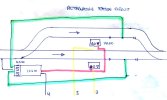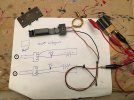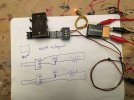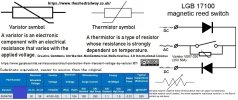So, looking at the "manual" it appears the 17100 has 2 diodes in it, and basically given an "input" of AC, you can have the switch pass either negative pulses or positive pulses.
I gather the little circles are the external connections. No idea why the internal biasing magnet is shown as a box with a slash.
Typically fed from AC
so in your circuit:
View attachment 308224
You want one OR the other 17100 triggered.
What do you think happens if
BOTH are triggered at the same time?
You apply FULL AC to the switch motor, which will not move it (it might buzz).
You need a way to be sure once triggered, then the loco get's OFF the reed switch.
You need a circuit that only allows the reed switches to act once and then that one is disconnected until the switch is tripped again








